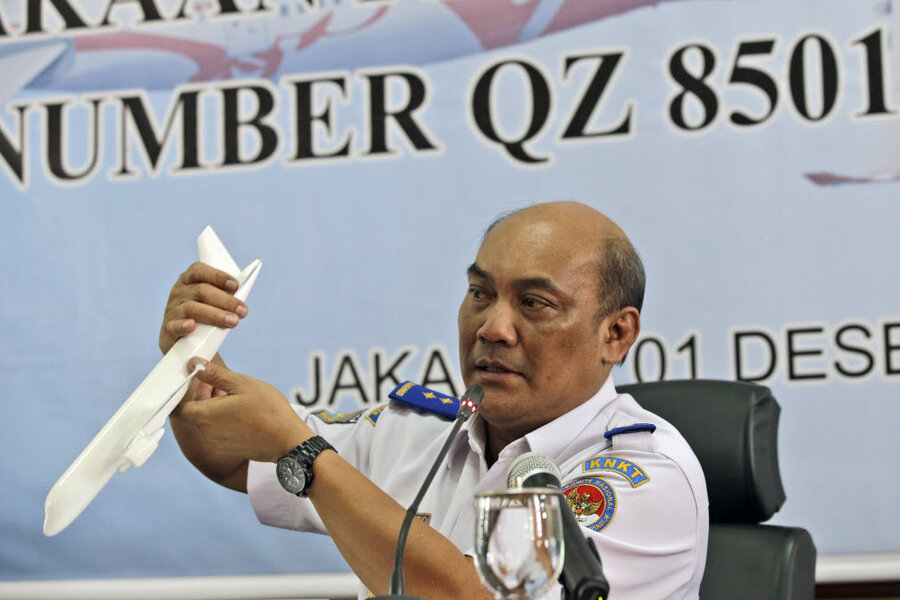AirAsia crash investigation: What have we learned so far?
Loading...
Mechanical problems and human confusion both contributed to Indonesia AirAsia Flight 8501's crash into the Java Sea last December, which killed all 162 passengers and crew, investigators reported on Tuesday.
Air accidents often develop from a complex series of events rather than clear-cut causes and subsequent investigations are less about affixing blame than about learning from past mistakes and preventing them from reoccurring.
"There is much to be learned here for Airasia, the manufacturer and the aviation industry. We will not leave any stone unturned to make sure the industry learns from this tragic incident," AirAsia GCEO Tony Fernandes tweeted.
Flight 8501 was en route from Surabaya, Indonesia to Singapore, a two-hour journey, when it crashed on December 28, 2014, closing a year with multiple devastating plane accidents, such as Malaysia Airlines Flight 370, which disappeared March 8 of that year, and Malaysia Airlines Flight 17, which was shot down near the Ukraine-Russia border several months later on July 17.
Initially, officials wondered if stormy weather may have played a role in the crash. But Tuesday's report, the first one made public, ruled that out as a cause. Instead, they said, problems with a chronically malfunctioning rudder system, and pilots' attempts to fix it, likely brought down Flight 8501.
Indonesia's National Transportation Safety Committee (NTSC) said that the Airbus A320's rudder-control system had malfunctioned four times during the flight, as well as 23 times in the previous year, potentially creating legal and public relations problems for Airbus, although the report is not meant to assign blame, and cannot be admitted in court.
But pilots' reactions to the rudder problems also contributed to the crash, investigators found. Data collected from the black box, which was located in January 2015, suggest an unusual decision to reset a circuit breaker mid-flight, in order to shut off the computer directing the rudder system, a move that would require the captain to leave his seat. Turning off that computer would also turn off the craft's autopilot.
"Subsequent flight crew action resulted in inability to control the aircraft," the NTSC said in a statement: for instance, investigators said that a pilot's command to "pull down," recorded on the black box, may have been confusing, since it is not a standard command to help avoid a stall.
"The computer was back on but it wasn't functioning to control [the aircraft]. If they'd wanted it to control again there's a button that must be pushed," NTSC investigator Nurcahyo Utomo told AP.
The NTSC said it had urged airlines to develop safety procedures to avoid "improvising" during a crisis.
AirAsia's Mr. Fernandes thanked the investigators on Twitter, adding "These are scars that are left on me forever but I remain committed to make Airasia the very best. We owe it to the families and my crew."
Indonesia AirAsia said it has modified pilot training and safety standards since the crash.
As the US Federal Aviation Administration highlights, common themes emerge from studying plane crashes, but many are downed by a "complex interrelationship of accident causes." In the shocked aftermath of a major accident, however, the public tends to want simple answers, like "mechanical error" or "terrorism."
Black boxes are one powerful tool for reconstructing a flight path and crew decisions to help avoid future accidents but they can't always solve puzzles, especially if the plane crashes at sea: the heavy recorders don't float and can be difficult to find on the bottom of the ocean.
But that could change: the aviation industry has discussed creating floating black boxes, or expensive but immediately helpful live streaming of the boxes' data.
"We forget at a time like this that every hour, every minute that the aircraft is lost is a lifetime for the family members," former U.S. National Transportation Safety Board Chairman Jim Hall told Bloomberg last January.
This report includes material from Reuters.








